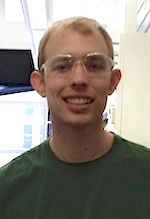Chemical strategy hints at better drugs for osteoporosis, diabetes
By swapping replacement parts into the backbone of a synthetic hormone, UW–Madison graduate student Ross Cheloha and his mentor Sam Gellman, along with collaborators at Harvard Medical School, have built a version of a parathyroid hormone that resists degradation in laboratory mice. As a result, the altered hormone can stay around longer — and at much higher concentration, says Gellman, professor of chemistry at the UW.

Sam Gellman
Hormones are signaling molecules that are distributed throughout the body, usually in the blood. Hormones elicit responses from only those cells that carry appropriate receptor molecules. “Receptors have evolved to recognize a very specific signal in a sea of biological fluids that is full of molecular messages,” Gellman says.
The relationship between a receptor and its signaling molecule is often likened to that between a lock and a key.
“We’re excited because we have preserved the ability to activate the receptor” by altering the backbone of the hormone, which holds the essential contact points in place, Gellman says. “While retaining, even enhancing, the signaling ability, we have diminished the peptide’s susceptibility to the biodegradation mechanisms that nature uses to eliminate signals over time.”

Ross Cheloha
Peptides are segments of proteins. Peptide hormones, like the better-known steroid hormones such as estrogen and testosterone, can convey a signal to billions of cells at once, even at tiny concentrations.
For a study published June 15 in Nature Biotechnology, the researchers altered a highly successful synthetic parathyroid hormone called teriparatide, which is used to combat severe osteoporosis.
But the real excitement of the discovery is the potential impact on a large class of peptide drugs, Gellman says. “A substantial group of receptors, including some involved in diabetes, respond to peptide signals, but peptides are quickly degraded in the body. Our approach seems to suggest a general strategy to retain the ability to target a specific receptor while diminishing the action of degrading enzymes. The key is that the receptor is looking for one shape while the destructive enzyme seeks a different shape.”
Gellman says the idea of replacing segments of the peptide backbone with artificial units once seemed heretical. “Most people expected that you could not change the backbone, which alters the spacing and orientation of the essential contact points, without making the molecule unrecognizable to the receptor.”
Potentially, the “alter-the-backbone” strategy could allow oral dosing of the rather fragile peptide drugs, which today must be injected to avoid destruction in the stomach and small intestine.
Gellman has assigned his rights for the discovery to the Wisconsin Alumni Research Foundation. The study’s first author, Cheloha, is a Ph.D. candidate in chemistry at UW–Madison. Co-author Thomas J. Gardella led a team at Harvard Medical School that conducted the biological assessments.
Potentially, the “alter-the-backbone” strategy could allow oral dosing of the rather fragile peptide drugs, which today must be injected to avoid destruction in the stomach and small intestine. By protecting the drugs from degrading enzymes, the new approach could also help sustain higher drug concentrations in the bloodstream.
The altered backbone also seems to make minor changes in signals that the receptor, once activated, transmits into the cell, Gellman says. “Changing the sites of backbone modification results in different profiles of response. Building drug molecules that activate only a certain type of response might allow us to dial out undesired side effects, but that’s just a hope at this point.”
To date, much of the focus on drug development has concerned the external features of signaling molecules, which directly contact a receptor, Gellman says. “The traditional approach is to keep the skeleton the same and modify the surface components. Our approach is just the opposite, keep the surface components the same, and modify the skeleton. Now that it is clear that this non-traditional approach can be successful, others are likely to try it.”
Tags: animal research, chemistry, drugs, research




